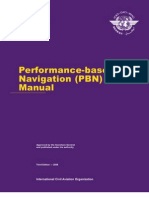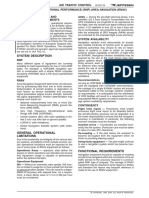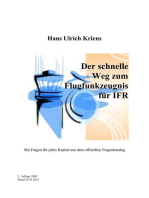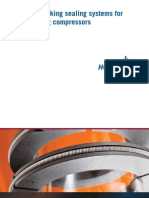General: Precision RNAV (P-RNAV) P-RNAV Is The Aircraft
General: Precision RNAV (P-RNAV) P-RNAV Is The Aircraft
Uploaded by
DIPCopyright:
Available Formats
General: Precision RNAV (P-RNAV) P-RNAV Is The Aircraft
General: Precision RNAV (P-RNAV) P-RNAV Is The Aircraft
Uploaded by
DIPOriginal Description:
Original Title
Copyright
Available Formats
Share this document
Did you find this document useful?
Is this content inappropriate?
Copyright:
Available Formats
General: Precision RNAV (P-RNAV) P-RNAV Is The Aircraft
General: Precision RNAV (P-RNAV) P-RNAV Is The Aircraft
Uploaded by
DIPCopyright:
Available Formats
19 DEC 08
AIR TRAFFIC CONTROL
551
REQUIRED NAVIGATIONAL PERFORMANCE (RNP) AREA NAVIGATION (RNAV)
GENERAL
RNP
The ICAO Special Committee on Future Air Navigation Systems (FANS) defines RNP as a statement of
required navigation accuracy in the horizontal plane
(lateral and longitudinal position fixing) necessary for
operation in a defined airspace. RNP types are identified by a single accuracy value, shown in the table
below. For example, the statement of RNP 1, refers to
a required navigation performance accuracy within 1
NM of the desired flight path at least 95% of the time
flying.
Table of existing and future levels of
navigation accuracy
RNP RNAV Type
RNP 1
RNP 4
B-RNAV (RNP 5)
RNP 10
RNP 12.6
RNP 20
Accuracy in the
designated airspace
1.0 NM
4.0 NM
5.0 NM
10.0 NM
12.6 NM
20.0 NM
B-RNAV (RNP 5) is a derivate of RNP 4, allowing continued operation without modification of existing route
structures and is implemented in the ECAC (European Civil Aviation Conference) Airspace.
Potential application for RNP airspace includes:
a defined airspace, such as North Atlantic minimum navigation performance specifications
(MNPS) airspace.
a fixed ATS route, such as between Sydney, Australia and Auckland, New Zealand.
random track operations, such as between Hawaii
and Japan.
a volume of airspace such as a block altitude on a
specified route.
The implementation of RNP allows enhancements of
ATC system capacity and efficiency while retaining or
establishing enhanced system safety.
RNAV
RNAV is the primary means of meeting RNP requirements. RNAV operations within the RNP concept
permit flight in any airspace within prescribed accuracy tolerances, without the need to fly directly over
ground-based navigation facilities. The application of
RNAV techniques provides a number of benefits, for
example:
establishment of more direct routes reducing the
flight distances.
establishment of dual or parallel routes to accommodate a greater flow of enroute traffic.
establishment of bypass routes for high density
traffic areas.
establishment of contingency routes.
establishment of optimum locations for holding
patterns.
reduces the number of ground navigation facilities.
Navigation parameters such as distance and bearing
to a way point are computed from the aircraft position to the location of the way point. Course guidance is generally derived from the linear deviation
from the desired track of a great circle course. The
desired course may be pilot elect able or may be
determined by the navigation computer through computations based on the locations of successive way
points.
Precision RNAV (P-RNAV) P-RNAV is the aircraft
and operator approval requirement that is introduced
for RNAV procedures in ECAC Terminal Airspace.
Terminal Airspace procedures that require P-RNAV
approval are designed following common principles
which ensure that procedure design and execution
are fully compatible. (RNP 1) - shall provide a 95%
containment value of 1 NM ( 1.85 km). This
level of navigation accuracy can be achieved using
DME/DME, GPS or VOR/DME. It can also be maintained for short periods using IRS (the length of time
that a particular IRS can be used to maintain P-RNAV
accuracy without external update is determined at
the time of certification.
Basic RNAV (B-RNAV) B-RNAV is the forerunner of
the RNAV programme. It was introduced to enable
capacity gains to be achieved through modifications
to the enroute structure. (RNP 5) - shall provide a
95% containment value of 5 NM ( 9.26 km). This
level is similar to that currently achieved by aircraft
without RNAV capability on ATS routes defined by a
VOR or VOR/DME, when VORs are less than 100
NM apart.
RNP AND RNAV REQUIREMENTS
For RNP and RNAV operations, operators have
the responsibility to ensure the required level accuracy, within the notified RNP/RNAV environment,
by means of appropriate equipment usage and prescribed procedures for the flight crew. It is essential
that ATC receives an indication from the operator
that a flight, planned along RNP/RNAV routes or
in a RNP/RNAV area, has the required navigation
capability.
APPROVAL AND CERTIFICATION
A fundamental requirement for the implementation of
RNP is the approval of flight operations in the various RNP type airspaces by the State of the operator.
Approval will be granted individually for each operator
and each individual aircraft type used by the operator. RNAV and FMS equipment also needs to obtain
airworthiness approval by the national authority. The
approving authority must ensure that aircraft equipment be installed and operated in a manner appropriate to the RNP type approval being sought. An
approval for a certain RNP type does not mean that
the aircraft may be operated wherever the RNP type
applies. The RNP type approval is specific to a particular type of navigation equipment and application,
and for the use of INS/IRS a time limit may apply. For
example, an aircraft, having approval for RNP 5 in the
B-RNAV airspace of Europe, using RNAV equipment
requiring input from ground based navigation facilities
such as VOR/DME may not be operated in a RNP 10
airspace where such facilities are not available.
q$z
JEPPESEN, 1999, 2008. ALL RIGHTS RESERVED.
q$i
You might also like
- Cessna172 R DGCA Question BankDocument2 pagesCessna172 R DGCA Question BankDIP75% (4)
- 737 Performance Reference Handbook - EASA EditionFrom Everand737 Performance Reference Handbook - EASA EditionRating: 4.5 out of 5 stars4.5/5 (3)
- Commercial Pilot Oral Exam Guide: The comprehensive guide to prepare you for the FAA checkrideFrom EverandCommercial Pilot Oral Exam Guide: The comprehensive guide to prepare you for the FAA checkrideRating: 3 out of 5 stars3/5 (2)
- Cessna152 Ques BankDocument23 pagesCessna152 Ques BankDIP100% (4)
- EIT 02-2002 Fire Alarm System StandardDocument181 pagesEIT 02-2002 Fire Alarm System StandardRebeccaNo ratings yet
- PBN Manual - ICAO Doc 9613 Final 5.10.08Document294 pagesPBN Manual - ICAO Doc 9613 Final 5.10.08Liviu Per100% (4)
- Navigation QuestionsDocument237 pagesNavigation QuestionsDIP75% (8)
- ANSI-NISO Z39.18 Scientific and Technical Report FormatDocument96 pagesANSI-NISO Z39.18 Scientific and Technical Report Formatjeffmefun100% (1)
- RNP NotesDocument40 pagesRNP Notesskynorth50% (2)
- ATPLViva QuestionsDocument27 pagesATPLViva QuestionscaptravipooniaNo ratings yet
- Pilot Reference BooksDocument4 pagesPilot Reference BooksDIP67% (3)
- Pennar Purlins SectionsDocument4 pagesPennar Purlins Sectionsmyusuf123No ratings yet
- Quality Manual SASB - APR - 2019 FinalDocument34 pagesQuality Manual SASB - APR - 2019 FinalVasudevan GovindarajNo ratings yet
- 487 Gps PPT Sept 2011Document73 pages487 Gps PPT Sept 2011Mahmed Adeeb100% (1)
- Understanding Required Navigation Performance (RNP) and Area Navigation (RNAV) OperationsDocument8 pagesUnderstanding Required Navigation Performance (RNP) and Area Navigation (RNAV) OperationsPablo Di GregorioNo ratings yet
- Performance Based Navigation (PBN)Document40 pagesPerformance Based Navigation (PBN)Bayu Chandra100% (4)
- Understanding Required Navigation Performance (RNP) and Area Navigation (RNAV) OperationsDocument8 pagesUnderstanding Required Navigation Performance (RNP) and Area Navigation (RNAV) OperationsaleNo ratings yet
- Normal Procedures: Airspace: Code7700 (Index - HTM)Document7 pagesNormal Procedures: Airspace: Code7700 (Index - HTM)Pero PericNo ratings yet
- Airspace RNAV Vs RNPDocument14 pagesAirspace RNAV Vs RNPPero PericNo ratings yet
- 5pbn Ac 91-003 Rnav1-Rnav2 EngDocument40 pages5pbn Ac 91-003 Rnav1-Rnav2 EngAbdel Hafid Lahreche100% (1)
- Advisory Circular: Subject: Aircraft and Operators Approval For RNP Approach (RNP Apch) OperationsDocument26 pagesAdvisory Circular: Subject: Aircraft and Operators Approval For RNP Approach (RNP Apch) OperationsJaime PinedaNo ratings yet
- Rnav Vs RNPDocument11 pagesRnav Vs RNPchamarousios123No ratings yet
- Rnav & RNP - Kfa NotesDocument29 pagesRnav & RNP - Kfa NotesPrashant Verma100% (1)
- 1_12---RNAV---RadioNavDocument32 pages1_12---RNAV---RadioNavirenehdzgrajNo ratings yet
- RNP Ar ApchDocument6 pagesRNP Ar Apch65mcw6ffdvNo ratings yet
- RNP Vs Rnav Vs RNP RnavDocument8 pagesRNP Vs Rnav Vs RNP Rnavtarun86100% (1)
- PBNDocument8 pagesPBNKedamawi RecordsNo ratings yet
- RNP APCHDocument13 pagesRNP APCHshammi tapseNo ratings yet
- Unit 2Document12 pagesUnit 2flywingsNo ratings yet
- Required Navigation Performance - WikipediaDocument7 pagesRequired Navigation Performance - WikipediaZenglei LiNo ratings yet
- Aviation What Is PRNAVDocument10 pagesAviation What Is PRNAVVito GentileNo ratings yet
- Awnot-070-Awxx-2.0-Implementation of Performance Based Navigation (PBN) in PakistanDocument7 pagesAwnot-070-Awxx-2.0-Implementation of Performance Based Navigation (PBN) in PakistanSamarNo ratings yet
- Air Pilots - Commercial Air Transport: Safety Briefing Note 08Document2 pagesAir Pilots - Commercial Air Transport: Safety Briefing Note 08Léa MercierNo ratings yet
- Welcome To Future Air Navigation System: PBN/RNPDocument35 pagesWelcome To Future Air Navigation System: PBN/RNPAuliya NurullahNo ratings yet
- PBN Reference Card V2Document3 pagesPBN Reference Card V2omarfredNo ratings yet
- Tac-033 Ac RNPDocument26 pagesTac-033 Ac RNPJSUROBOYONo ratings yet
- 8260 55Document12 pages8260 55JAIRONo ratings yet
- Area NavigationDocument4 pagesArea Navigations parasdNo ratings yet
- Operations Circular 05 of 2018: Government of India Civil Aviation Department Director General of Civil AviationDocument8 pagesOperations Circular 05 of 2018: Government of India Civil Aviation Department Director General of Civil Aviationmehul da aviatorNo ratings yet
- Required Navigation PerformanceDocument1 pageRequired Navigation PerformanceCerose SakilNo ratings yet
- Ac 90-96a CHG 1Document27 pagesAc 90-96a CHG 1sandraNo ratings yet
- P RNAV DefinitionDocument24 pagesP RNAV DefinitionVito Gentile100% (2)
- Faa B-RnavDocument10 pagesFaa B-RnavMikeNo ratings yet
- What Is B-RNAVDocument10 pagesWhat Is B-RNAVRoman KytsaniukNo ratings yet
- Advisory Circular: Subject: Use of Suitable Area Navigation Date: 4/21/15 AC No: 90-108 Initiated By: AFS-400 Change: 1Document11 pagesAdvisory Circular: Subject: Use of Suitable Area Navigation Date: 4/21/15 AC No: 90-108 Initiated By: AFS-400 Change: 1rdpereirNo ratings yet
- Required Navigation Performance (RNP), Area Navigation (RNAV) ImplementationDocument15 pagesRequired Navigation Performance (RNP), Area Navigation (RNAV) ImplementationvinantigoNo ratings yet
- Operations Circular: OC NO 11 OF 2014 Date: 04 SEPT. 2014Document36 pagesOperations Circular: OC NO 11 OF 2014 Date: 04 SEPT. 2014mehul da aviatorNo ratings yet
- RNAV QFSheetDocument2 pagesRNAV QFSheetZenglei LiNo ratings yet
- System Description: Jeppesen, 1999, 2008. All Rights ReservedDocument1 pageSystem Description: Jeppesen, 1999, 2008. All Rights ReservedDIPNo ratings yet
- Required Navigation Performance (RNP) : RNP Terms and AbbreviationsDocument3 pagesRequired Navigation Performance (RNP) : RNP Terms and AbbreviationsFco Javier CruzNo ratings yet
- 08 - RNP ApchDocument91 pages08 - RNP Apchmaxiss4us100% (1)
- Ac90-105 RNPDocument39 pagesAc90-105 RNPMarko Ivankovic100% (1)
- AERO 2011q4 Article5Document5 pagesAERO 2011q4 Article5nunov_144376No ratings yet
- AC 90-100A RC Compliance Matrix PDFDocument14 pagesAC 90-100A RC Compliance Matrix PDFArun SasiNo ratings yet
- GCAA CAAP 52 October UpdateDocument67 pagesGCAA CAAP 52 October UpdateJazon AlvesNo ratings yet
- Advisory Circular: Subject: Approval Guidance For RNP Date: 2/23/11 Initiated By: AFS-400 AC No: 90-101A ChangeDocument43 pagesAdvisory Circular: Subject: Approval Guidance For RNP Date: 2/23/11 Initiated By: AFS-400 AC No: 90-101A Changenunov_144376No ratings yet
- Advisory Circular: U.S. Department of TransportationDocument19 pagesAdvisory Circular: U.S. Department of TransportationrdpereirNo ratings yet
- Easy Access Rules AMC 20 AMC 20 4Document7 pagesEasy Access Rules AMC 20 AMC 20 4JMNo ratings yet
- Web - AC 90-100A RC Compliance Matrix PDFDocument14 pagesWeb - AC 90-100A RC Compliance Matrix PDFRuben FigueroaNo ratings yet
- RNP 2Document143 pagesRNP 2eak_ya5875No ratings yet
- PBN ReviewDocument14 pagesPBN Reviewngminhhoangdeptrai07No ratings yet
- PBN Today and TomorrowDocument27 pagesPBN Today and TomorrowJohnNo ratings yet
- Ac 32-Area Navigation - Rnav 2 & 1Document5 pagesAc 32-Area Navigation - Rnav 2 & 1KINGDOEMSELYNo ratings yet
- PBN Plan IndiaDocument17 pagesPBN Plan IndiaRajiv KumarNo ratings yet
- Encyclopaedia of International Aviation Law: Recueil Des Textes De Lois Relatifs AFrom EverandEncyclopaedia of International Aviation Law: Recueil Des Textes De Lois Relatifs ANo ratings yet
- Airline Transport Pilot Oral Exam Guide: Comprehensive preparation for the FAA checkrideFrom EverandAirline Transport Pilot Oral Exam Guide: Comprehensive preparation for the FAA checkrideNo ratings yet
- Aircraft Dispatcher Practical Test Standards (2025): FAA-S-8081-10EFrom EverandAircraft Dispatcher Practical Test Standards (2025): FAA-S-8081-10ENo ratings yet
- Da CalculationDocument1 pageDa CalculationDIPNo ratings yet
- Aviation Maths Links-06march23Document2 pagesAviation Maths Links-06march23DIPNo ratings yet
- Pilot General Navigation Solved Problems-Set1Document4 pagesPilot General Navigation Solved Problems-Set1DIP100% (1)
- Jeppesen, 2002, 2009. All Rights ReservedDocument1 pageJeppesen, 2002, 2009. All Rights ReservedDIPNo ratings yet
- Presentation Built in Oven - IFBDocument13 pagesPresentation Built in Oven - IFBDIPNo ratings yet
- Tech Specific 172 RDocument28 pagesTech Specific 172 RPrerak Kumar100% (1)
- 1 - Collected & Compiled by SQN LDR Vikram SavekarDocument31 pages1 - Collected & Compiled by SQN LDR Vikram SavekarDIP50% (2)
- Oca CirclingDocument1 pageOca CirclingDIPNo ratings yet
- Q Paper 1 Tech GenDocument8 pagesQ Paper 1 Tech GenDIPNo ratings yet
- Mumbai VABBDocument67 pagesMumbai VABBDIP100% (1)
- CPT Mock Test Paper Dec 2014 Part A English 28-11-2014Document13 pagesCPT Mock Test Paper Dec 2014 Part A English 28-11-2014DIPNo ratings yet
- Aquaponics InfoDocument31 pagesAquaponics InfoDIPNo ratings yet
- IlsDocument22 pagesIlsHemantkumar TungNo ratings yet
- Abbreviations Rtr-A IndiaDocument13 pagesAbbreviations Rtr-A IndiaDIP100% (1)
- RTR Interview1Document142 pagesRTR Interview1DIP0% (1)
- (Vomm17) Ils25 (BW)Document1 page(Vomm17) Ils25 (BW)DIPNo ratings yet
- Sample Question Bank: Frto ExamDocument6 pagesSample Question Bank: Frto ExamDIP100% (1)
- Discovery Chapter 1 Her Choice, A Clannad Fanfic FanFictionDocument18 pagesDiscovery Chapter 1 Her Choice, A Clannad Fanfic FanFictionRiss EdullantesNo ratings yet
- Sika PDS - E - SikaGrout - 212 GP PDFDocument2 pagesSika PDS - E - SikaGrout - 212 GP PDFlwin_oo2435No ratings yet
- Écho A1 Partie 1 Pages 1-50 - Flip PDF Download - FlipHTML5 PDFDocument87 pagesÉcho A1 Partie 1 Pages 1-50 - Flip PDF Download - FlipHTML5 PDFMicaela SaavedraNo ratings yet
- Schneider MODBUS RTUDocument2 pagesSchneider MODBUS RTUabdolbazNo ratings yet
- TP Price ListDocument10 pagesTP Price ListJesse GarciaNo ratings yet
- FTA LNB-Switch Guide & InfoDocument10 pagesFTA LNB-Switch Guide & InfoAlberto QuinteroNo ratings yet
- ISO 9863 1 2005 en PreviewDocument7 pagesISO 9863 1 2005 en PreviewKhushwant BansalNo ratings yet
- International System of UnitsDocument11 pagesInternational System of UnitsshashwatsinhaNo ratings yet
- System ComponentsDocument11 pagesSystem ComponentsAnonymous U4PV5A0No ratings yet
- Reaffirmed 2005Document12 pagesReaffirmed 2005amitkap00rNo ratings yet
- ABC CostingDocument2 pagesABC CostingChrissa Marie VienteNo ratings yet
- Programe in CDocument7 pagesPrograme in CMoksedul AlamNo ratings yet
- ACB Technical+Manual EDocument156 pagesACB Technical+Manual EDũng Nguyễn Thế100% (2)
- Data Sheet Triac - Bta41-800b - To - btb41-800bDocument7 pagesData Sheet Triac - Bta41-800b - To - btb41-800bAdalberto CoelhoNo ratings yet
- Unit I: CODES AND REGULATIONS - : Lesson 1: The National Building Code of The PhilippinesDocument27 pagesUnit I: CODES AND REGULATIONS - : Lesson 1: The National Building Code of The PhilippinesStevenNo ratings yet
- Markdown Syntax Cheat SheetDocument2 pagesMarkdown Syntax Cheat Sheetapi-26005022No ratings yet
- Compressor DocsDocument28 pagesCompressor DocsMohd Yameen100% (1)
- 3HAC024480-011 Controlador IRC5 ArmarioDocument162 pages3HAC024480-011 Controlador IRC5 ArmarioMaxfoxNo ratings yet
- Detailed Specifications of Fire Retardant DoorsDocument5 pagesDetailed Specifications of Fire Retardant Doorsprakash.jay21No ratings yet
- LTE Drive Test ProcedureDocument15 pagesLTE Drive Test ProcedureYêkouté N'yabaNo ratings yet
- CDGS PhotoPaintDocument5 pagesCDGS PhotoPaintYasser E KasanNo ratings yet
- Hole PreparationDocument3 pagesHole Preparationtanha56313955No ratings yet
- Performance Specification For Wig Wag Signal Control EquipmentDocument14 pagesPerformance Specification For Wig Wag Signal Control EquipmentKishanNo ratings yet
- Approaches To HR EvaluationDocument4 pagesApproaches To HR Evaluationkocherlakotapavan0% (1)
- Technical Documents - CatalogDocument72 pagesTechnical Documents - CatalogkramaseshanNo ratings yet
- SCCANZ Smart Cities Standards Guidance Note - ISSUEDocument14 pagesSCCANZ Smart Cities Standards Guidance Note - ISSUEGina Ortega Calderón100% (1)














































































































